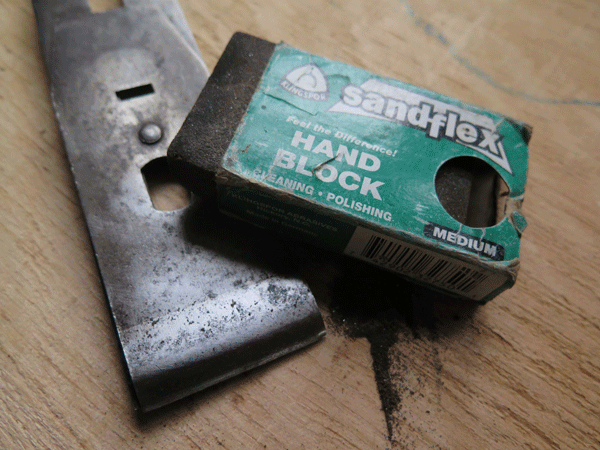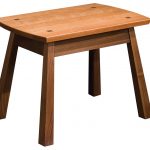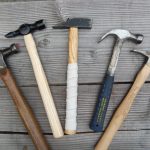We may receive a commission when you use our affiliate links. However, this does not impact our recommendations.
Most of my good woodworking tools have sat idle since April 10 or so, when I packed them up to move out of my old house, then hauled them to the Popular Woodworking shop for storage and safekeeping during my brief period of relative homelessness. (I was living at a friend’s house, and only until I could find a new place to buy – no sense in hauling my tools with me with no place to use them.)
While I’m now in my new house and those boxes and bins have been moved into my basement (where I’ll be setting up shop), most of the tools I’ve been wielding since August 1 (the first day I had access to the entire place, after the downstairs renters were gone) have been used for destruction as I return the house to its former one-family configuration. That would be a reciprocating saw, crowbars and moulding bars, framing hammers, nail pullers…not much call for my No. 7 or bevel gauges just yet.
I had everything packed in sealed boxes, and included therein desiccant packs cadged from pill bottles, as well as a couple silica gel dehumidifiers from Lee Valley Tools. And, our shop is air-conditioned – so I wasn’t anticipating any problems when I unpacked. I should have. I live in the evil-to-iron Ohio River Valley.
The best way (I think) to keep tools rust-free is to use them regularly, and wipe them down after every use with an oil-soaked rag. I use jojoba oil on a well-soaked microfiber cloth – the SuperWoobie(tm), as Christopher Schwarz calls it. Others prefer camellia oil or WD-40 – whatever – any non-drying vegetable oil will do.
But when you’re not using your tools and wiping them often, little blooms of rust start to rear their ugly blossoms. I’ve begun unpacking as I’ve needed specific tools, and almost every piece of iron has a spot here or there that needs addressing.
So, instead of a sharpening station (which would have been my first setup at the sink), I’ve set up a de-rusting station. I have a piece of plywood on sawhorses in front of the slop sink, and atop it, my three Klingspor Sandflex blocks (coarse, medium and fine). These rubber-like blocks are impregnated with grit, and are basically magic erasers for rust.
Because what I’m attacking are generally small spots of recent rust, I’m able to remove most of them using the fine block (which is good – it produces fewer scratches on the surface). If “fine” doesn’t do it, I go to “medium” or “coarse” as needed, then work my way back down to fine to mitigate the scratches.
Then, of course, I wipe the metal with my oiled cloth, and put the tool in my chest, where it will be better protected from dust (and the nefarious salts and moisture therein).
Thus far, I haven’t encountered rust enough to make me cry…but if I do, I’m ready for that as well. Below the sink is a plastic bin containing an old toothbrush and a bottle of Evapo-Rust. It’s a relatively safe liquid (though I still wear gloves whilst using it – wouldn’t want to ruin my manicure) that can be dumped down the sink when you’re done. I hope I don’t have to use it, but if I do, I’ll simply remove any wooden bits (say, the tote and knob from a handplane), take the tool apart and drop all the pieces into an Evapo-Rust bath for a few hours, then take them out and scrub off (with the toothbrush) the offending blooms (or use a razor knife). If that takes care of it, great. Rinse off the pieces, wipe them well with my oily cloth, reassemble and I’m ready to go. If not, it’s back in the drink for a few more hours.
So, given the small bits of rust already encountered, I’ll be unpacking my tools now with a bit more alacrity, and touching things up as needed then putting them in their proper place. I’d rather not have to give anything a bath, when a few judicious wipes could do.
And I’ll start to use the tools again…that’s the best defense, and the most fun.
P.S. If you have tool care and maintenance questions, or enjoy finding old tools and giving them new life, check out our new “mini-kit” – the “Tool Rehab Collection” with the DVD “Super-Tune a Handplane” by Christopher Schwarz and “Super-Tune Your Backsaw” by Matt Cianci, and the revised edition of Michael Dunbar’s classic book, “Restoring, Tuning, and Using Classic Woodworking Tools.” The three together are just $39.99 (50 percent off the retail price).
Here are some supplies and tools we find essential in our everyday work around the shop. We may receive a commission from sales referred by our links; however, we have carefully selected these products for their usefulness and quality.











Well, it looks like I made a decent choice for my “spontaneous purchase.” Had a similar situation with my jointer (stored in a storage locker for a couple of months.) Most of it came off with a green scotch-brite but there are still a few minor patches that I was going to hit with some 400 grit and WD40 (love that stuff, especially for bee stings). I saw these Sandflex things and bought a fine version. Humm, seems like I made the right decision for a change!
“I wipe the metal with my oiled cloth, and put the tool in my chest”
That last part bears repeating. We share the SW Ohio humidity, and it’s regional peculiarities in as far as metal tools, and tool surfaces go. A wooden toolbox for your hand tools is almost like putting them into a safety cocoon. Rust spots are immediately decreased at least 10 fold.
Here’s to being back in the shop 🙂
Great advise and it is simple to do. Wearing gloves to protect your manicure is smart, but be careful which toothbrush you pick up to brush your teeth.
A fine wire wheel on a grinder works beautifully, particularly if you are refurbishing fairly rusty tools.
Here’s a link to Klingspor’s website where I just bought a 3 pack for 9.95…
http://www.woodworkingshop.com/product/sa99996/#.Vebq4EsbAwB
Looking forward to trying them out.
Megan, those Sandflex blocks are my favorite. Makes you wonder how we got along without them.